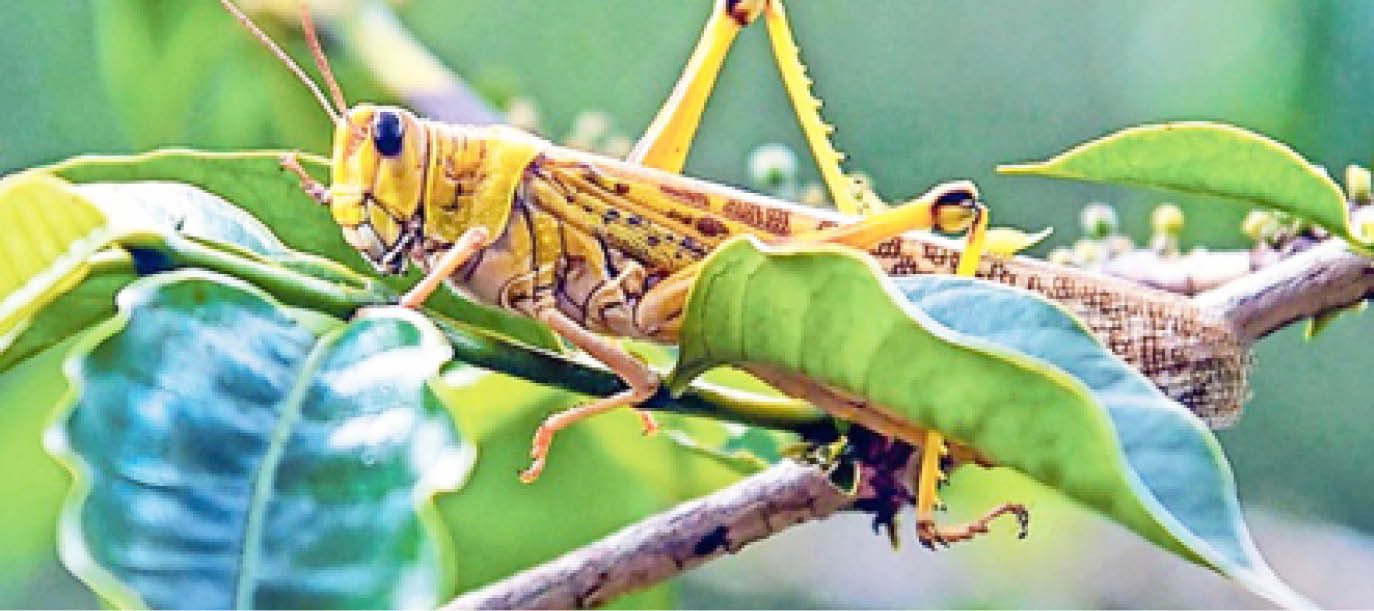Desert locust (Schistocerca gregaria) is a large herbivore insect that looks like a grasshopper, is short-horned and is approximately the length of a finger (two to three inches).
Since the dawn of civilisation, locusts have been feared agricultural pests, with plagues documented in ancient texts, including in the Qur’an, Bible and Torah.
Locust outbreaks can occur on all the continents, with the exception of Antarctica, and have the potential to affect the livelihoods of one in 10 people on the planet.
A single locust swarm can contain billions of insects and travel hundreds of kilometres each day. According to Food and Agriculture Organisation, swarms can travel up to 130km per day and a kilometre-wide swarm can contain up to 80 million locusts.
The insects inhabit over 60 countries in Africa, Asia and Middle East and can cover one-fifth of earth’s land surface as the plagues threaten the economic livelihood of one-tenth of the world’s humans.
The desert locusts have largely destroyed livestock pasture in rangelands and the relatively small patches of farms in the arid and semi-arid counties and have strong preference for grass or graminaceous plants, such as millet and maize.
Biology and life cycle of desert locust
Because of the widespread importance of locusts and the ease with which they can be maintained in the laboratory, their biology has been more extensively studied than that of any other insect.
In many instances, emphasis is placed on the three locust species in Africa and the Middle East, namely Schistocerca gregaria, Locusta migratoria and Nomadacris septemfasciata, which all live for about three to five months.
Changes in colour
The insect’s phenotypic changes in colouration (also called phase polyphenism) is often the most conspicuous feature. That is why they can be yellow, brown or sometimes green, depending on the stage.
Other features are solitarious phase and gregarious phase, which are related to behavioural changes. Normally, a solitarious locust (eating and living alone or in a few numbers) will switch from avoiding other locusts to exhibiting gregarious behaviour after only a few hours of crowding.
Once locusts become attracted rather than repelled by others, a positive feedback loop is established that can drive an initially solitarious population to the gregariousness phase, when they swarm and move for long distances. Locusts migrate in swarms often by flying with prevailing winds that take them to regions where air masses may collide, produce rainfall, and potentially generate suitable habitat.
The current outbreak is caused by winds coming into East Africa from the Middle East.
How, why do swarms form?
Locust population growth and swarm formation is highly affected by weather conditions. This is because good weather promotes growth of host plants and provides soil moisture for egg development.
Closely distributed vegetation and quality resources in the habitat can either promote or deter contact among individuals, and hence influence the probability of locusts entering the gregarious phase.
Reduced food plant sources or areas of favourable microclimate encourage solitarious locusts to come into contact and gregarise, despite their initial tendency to be repelled by one another.
In contrast, more dispersed resources allow solitarious locusts to avoid one another and inhibit gregarisation, thus reducing their spread.
In most cases, the life cycle comprises egg, hopper (nymph) and adult. Eggs normally hatch in about two weeks, depending on temperature.
The Desert Locust Control Organization for Eastern Africa is the main body mandated to work with FAO in management of the pest in East Africa.
Currently, desert locusts are mainly controlled through spraying of chemicals, which can be done on the ground or through aerial spraying.
Pesticides use in the control of locusts is a source of concern, as they might have devastating effects on other beneficial insects such as bees, which contribute to ecosystem health.
The use of biopesticide (biological control) is most appropriate and a major bio-agent is called Metarhizium, sold as Green guard.
This is a biological control agent that can be used in environmentally-sensitive areas and in those under organic farming.
The agent is derived from a naturally-occurring Australian fungus (Metarhizium anisopliae) that attacks locusts. Also used are spores of naturally occurring fungus Metarhiziumanisopliaevar. acridum, sold as Green muscle, which germinates on the skin of locusts and penetrates through their exoskeletons, have been used.
The fungi can then destroy the locust tissues from the inside. Also, the use of insect growth regulators; a class of products that influences the ability of hoppers to moult and grow properly.
They have no direct toxic effects on vertebrates. Other chemicals recommended for use are Fenitrothion, registered for use against locusts on pasture and a wide range of cereal and other crops. It is available for ground control and as a ultra-low volume (ULV) formulation for aerial control.
Fipronil is also a ULV formulation for aerial control, and is suitable for pasture and sorghum situations while Chlorpyrifos is suitable for ground control only in crop or pasture situations.
While using these pesticides, care should be taken to ensure sensitivity of the crops, humans, pasture, stock or sensitive site scenarios and environmental considerations including beneficial insects, mainly bees, which produce valuable honey in affected dryland counties.
The piece authored by Paul Kimurto & Fred Kemboi appeared in Seeds of Gold of Daily Nation of Kenya.

 Join Daily Trust WhatsApp Community For Quick Access To News and Happenings Around You.
Join Daily Trust WhatsApp Community For Quick Access To News and Happenings Around You.

